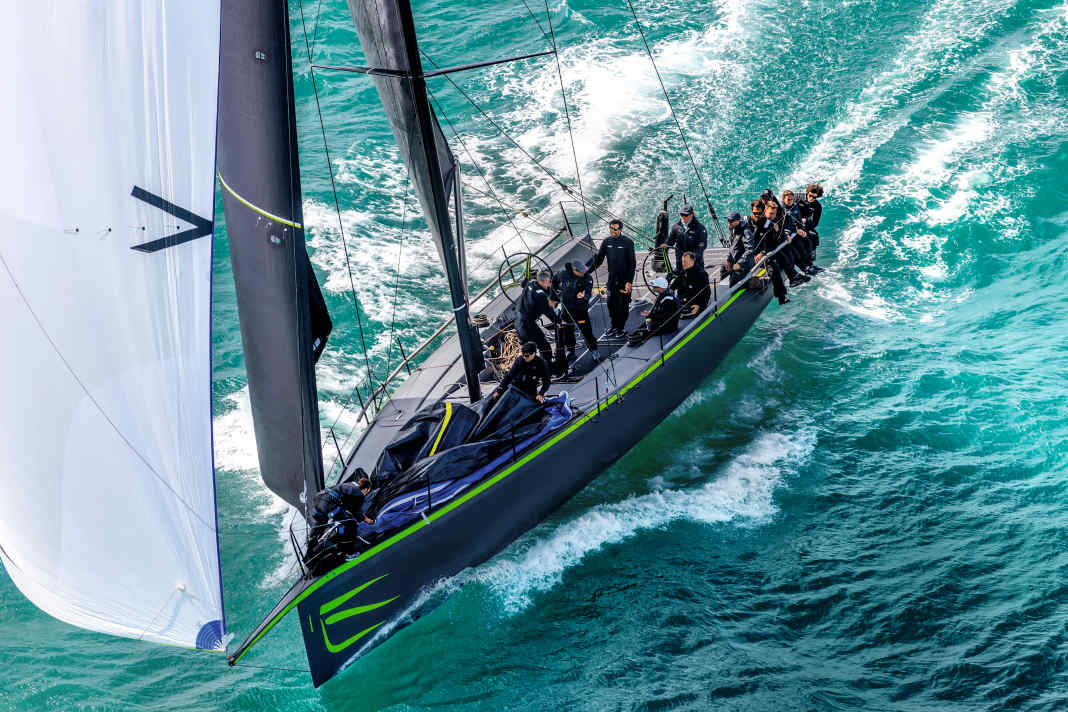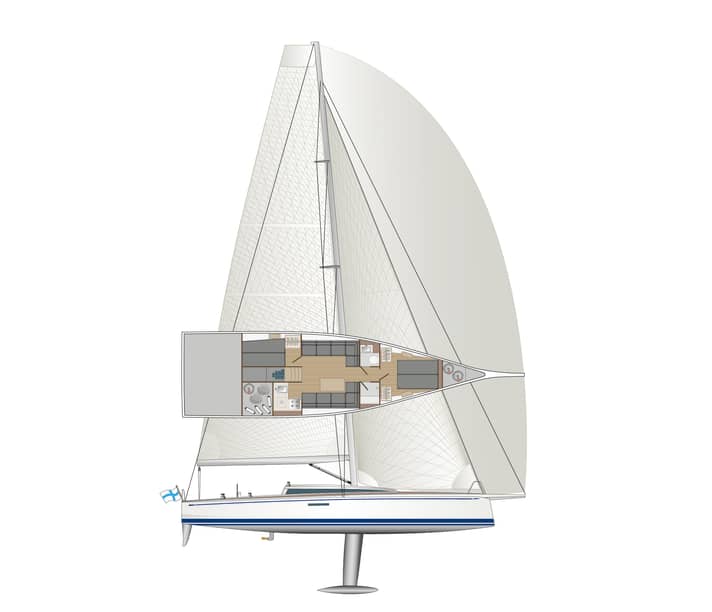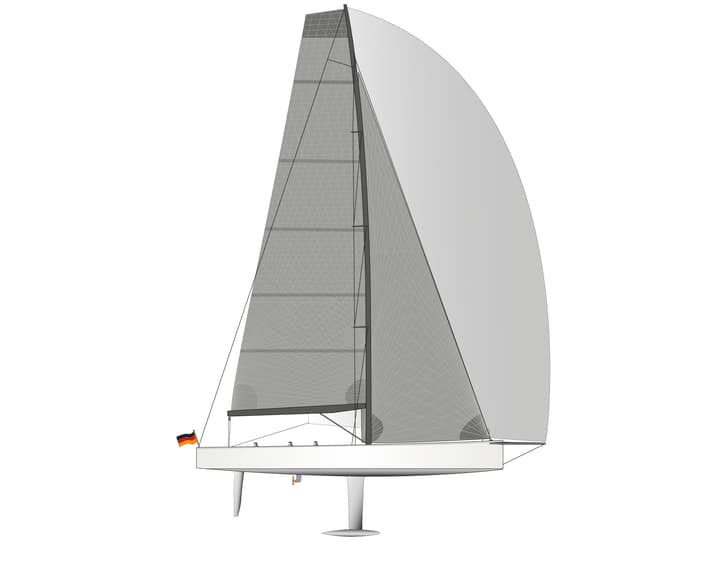





- Attack with the Wallyrocket 51
- The rocket is a lightweight
- Uncompromisingly regatta-compatible
- Printing for the Wallyrocket 51
- The inside of the Wallyrocket 51 is hollow
- The rocket needs water
- The Wallyrocket 51 flies
- Technical data of the Wallyrocket 51
- The competition for the Wallyrocket 51
Three, two, one - hoist. The gennaker goes up and immediately sets perfectly. With only twelve knots of true wind, the log jumps into double figures. At the tiller: none other than Luca Bassani, chief designer and founder of Wally Yachts. A man who is used to setting standards - and who wants to open a new chapter in performance sailing with the Wallyrocket 51.
Attack with the Wallyrocket 51
The Wallyrocket 51 was officially launched on 14 October 2024. The news spread like wildfire in the sporting regatta scene. No wonder: the name Wally is familiar to sailors, but stands for stylish maxis and mega yachts - the fact that the Italian luxury brand is now competing with established classes such as the Transpac 52 (TP52) or the ClubSwan 50 is causing quite a stir. Do we need another class in an already well-established size and with a similar target group? Perhaps not. But as with a 69-foot Hallberg-Rassy or even a TP52, it's not about having to - it's about wanting to. And with style and pure conviction.
The 15.5 metre long racing yacht was designed by the Spanish design studio Botin Partners - known for their successes in the America's Cup and even more so for the TP52 series. The aim of the project was to design a yacht that not only functions as a one-design class, but also sails at the front in IRC and ORC fields. The result: a rather slim, aggressive racer with a long overhang and radical T-keel.
The rocket is a lightweight
The Wallyrocket 51 is built using an uncompromising lightweight construction method: The hull consists of a foam core with carbon laminate, the deck of No-mex honeycomb core - an ultra-light aramid material used in high-tech yacht and aircraft construction. Laminated exclusively with prepreg carbon fibre. Prepreg - i.e. laminate pre-impregnated with resin - allows the construction of particularly rigid and lightweight structures. There is hardly a more modern way to build a yacht.
The sail area is no less impressive: 167 square metres upwind, 363 square metres downwind - the gennaker alone has 265 square metres. By comparison, a Hanse 510 of the same size uses 206 square metres of gennaker area. The Wallyrocket 51 is therefore on a par with a TP52 - but with significantly less weight.
Uncompromisingly regatta-compatible
The cloth comes from North Sails and is made of the currently popular 3Di material - top shelf. The deck layout is also uncompromisingly designed for racing: Double helm stations, flat superstructures, clear runways, perfectly positioned winches. Everything is trimmed for fast, precise handling. The boat is sailed with a crew of between eight and eleven people (maximum crew weight 935 kilograms). Optionally also available with electric winches, which enable reduced crew operation for offshore races or owner-driver events.
When I founded Wally, I wanted to build sailing boats that were both very comfortable and easy to sail and very fast for regattas." Luca Bassani
The Wally has six carbon and aluminium Harken winches - two primary winches, two for the mainsail and two for the backstays - as well as a further air winch for the pit. The two primary winches and the port mainsheet winch are operated hydraulically via the on-board hydraulic system. Foot switches on the deck are used for operation. The remaining winches are operated manually with cranks. Most of the other deck hardware also comes from Harken. A special detail: the fittings on the rig are made almost entirely of titanium - it couldn't be lighter or more modern.
Two carbon fibre grinders and an associated shaft drive system with gearboxes are also installed. This system optionally operates the primary winches, the port mainsheet winch, the spinnaker furling line and the manual hydraulic pumps. One is installed at the stern and one at approximately the same height as the two primary winches.
Printing for the Wallyrocket 51
Hydraulics is the key word here. On the Wallyrocket, not everything is operated by a stretcher - some functions run at the touch of a button. For example, the cunningham of the jib is tightened at the touch of a button. Integrated load sensors indicate the tension on the luff. The inhaulers of the jib, the height adjustment of the foresail (as a replacement for a centreboard) and the backstay deflectors are also connected to the system - including load measurement. The system is controlled via buttons on deck.
Classification: A deflector regulates the mast bend and counteracts the pull of the forestay of the selected jib. Similar to what the backstays do, but further down. The system is used to further influence the mast curve. The mast comes from Southern Spars and is designed for performance-orientated inshore regatta sailing with a professional crew. It is a fractional rig made from high-modulus prepreg carbon fibre, which is baked in an autoclave at 120 degrees Celsius. This gives it its final high strength.
The rig has three pairs of aerodynamic spreaders inclined aft and double aft stays. The forestay and V1 shrouds are equipped with Synapse load sensors. The mast foot allows mast rotation of around two per cent per direction and has a manual drive screw for longitudinal adjustment when the mast is unloaded. In addition, a hydraulic stroke is integrated with which the entire rig tension can be fine-tuned.
The inside of the Wallyrocket 51 is hollow
Anyone entering the hull of the Wallyrocket 51 will look in vain for what is usually associated with yachts: an interior. There is no panelling, no galley, no upholstery, no comfort zones. Instead, visitors are greeted by a sparse, highly functional world of exposed carbon fibre, exposed frames and structural elements - beautiful! A classic interior? Not a thing. Everything is trimmed for lightweight construction and performance. Even the usual floorboards are missing, instead there is an anti-slip coating.
In the foredeck: storage space for the large gennaker and various headsails. A maximum of ten sails are on board. However, only three of these are gennakers. One A1, one A2 and one A4. The rest are various jibs, staysails, J-Zero or a Code Zero.
The rocket needs water
The integrated water ballast system is a novelty. The yacht has two permanently laminated tanks - one on each side. Each tank holds around 640 litres and is divided into two zones. Two retractable valves allow seawater to flow in during the journey, which is filled via an electric pump in around 60 seconds (depending on the speed of the boat). The transfer to the new leeward side takes place by gravity - in only about seven seconds. An electric pump helps with transferring and emptying. The entire system is manufactured by Diverse in England and is pneumatically controlled via a digital deck switching system. This offers significant advantages, especially on upwind courses.
The idea behind the Wallyrocket 51 is to create a very strict one-design class that offers pure racing, is highly technical, but is also competitive under IRC and ORC rules." Adolfo Carrau
The Wallyrocket 51 clearly shows what it is: not a cruiser, not a compromise - but a racing boat in the purist sense. According to the shipyard, a small carbon fibre toilet, tubular bunks and a carbon pantry are provided for long-distance racing. But enough of the technology show - now it's time to get out on the water. There is only a light breeze in the morning. Three, maximum five knots. But even with this breeze, the Rocket slowly gets going. The crew - including Nicholas Brezzi (America's Cup, Luna Rossa) - is well-rehearsed, works routinely and efficiently, even with the guests on board. Hardly any words are needed, everything works. Also on board: Vasco Vascotto, 25-time world champion tactician. No wonder everything runs like clockwork.
The Wallyrocket 51 flies
After the first few miles have been sailed, the wind picks up. Seven to twelve knots, up to 15 in gusts. The Rocket can be sailed precisely and directly upwind - almost like an Ilca. Every breeze is transformed into propulsion. You hardly feel the 50-foot length. And downwind? The Rocket lives up to its name. From 11 knots of true wind, it runs faster than the wind itself - up to 12 knots in gusts. The typical creaking and humming of a carbon hull accompanies the spectacular experience.
After a few problem-free gybes, the gennaker is ready to be recovered. Similar to a TP52 - or a small 49er - the sheet remains in place for a long time and is only removed shortly before the buoy. Motto: Whoever is faster for longer is faster. The gennaker is recovered using the string-drop method. Important: The halyard must be slack in a flash, otherwise the thin cloth will tear. A recovery line reaches into the centre of the sail and leads through the fore hatch below deck. The halyard is completely released at the leeward buoy, the cloth collapses and is pulled in at lightning speed - before it even touches the water.
Below deck, reelers, also known as sheet suckers, help with tidying up. These drums automatically roll up superfluous lines. This improves manoeuvres and reduces the risk of getting caught to practically zero. In the test, we recovered the gennaker a little more slowly. During a test run, the light cloth was somewhat damaged. You probably don't want to repeat that today.
On cross and downwind courses, we should be faster than any other boat, even though we are smaller and lighter." Guillermo Parada
Despite all the technology, the Wallyrocket 51 remains accessible - at least for ambitious sailors. It is explicitly designed as an owner-driver racer. A crew of eight to eleven people is ideal - thanks to the optional electric winches, fewer people are also possible. This means that nothing stands in the way of participation in a wide variety of formats: one-design races, offshore regattas - anything is possible. Sailing greats such as Vascotto and Guillermo Parada were involved in the development right from the start. Their goal: a yacht that is fast on any course, remains competitive - and retains its value even after years. "We wanted a boat that not only wins, but also stays," says Parada. A racer for enthusiasts - with an eye for the extraordinary.
And the Wallyrocket 51 has already proven that the yacht works: On her debut at the ORC Central and Southern Tyrrhenian Championship, she sailed to strong placings and fought exciting battles with the Turkish TP52 of the Arkas Sailing Team. An impressive baptism of fire. And a clear signal: Wally doesn't just want to compete - she wants to win.
Technical data of the Wallyrocket 51

- CE design category A
- Hull length 15,50 m
- Waterline length 14,68 m
- Width 4,32 m
- Draught 3,50 m
- Weight 6,25 t
- Mainsail and genoa 167,0 m²
- Gennaker 265,0 m²
- Sail carrying capacity 7,0
The competition for the Wallyrocket 51
ClubSwan 50

The ClubSwan 50 was launched to mark the 50th anniversary of the shipyard. Still a modern cruiser/racer with large fields. The boat was conceived as a one-design class, similar to the Wallyrocket 51. Hull length 16.74 m; width 4.20 m; weight 8.5 tonnes; from 1.5 million euros. To the test...
TP 52

They are probably the Wallyrocket 5's biggest rivals: the high-performance Grand Prix yachts are sailed in a highly professional manner. There are usually nine boats at the start. This is a box-rule construction class. Hull length 15.85 m; width 4.42 m; weight 6.98 tonnes; from 2.5 million euros. More about the TP52...

